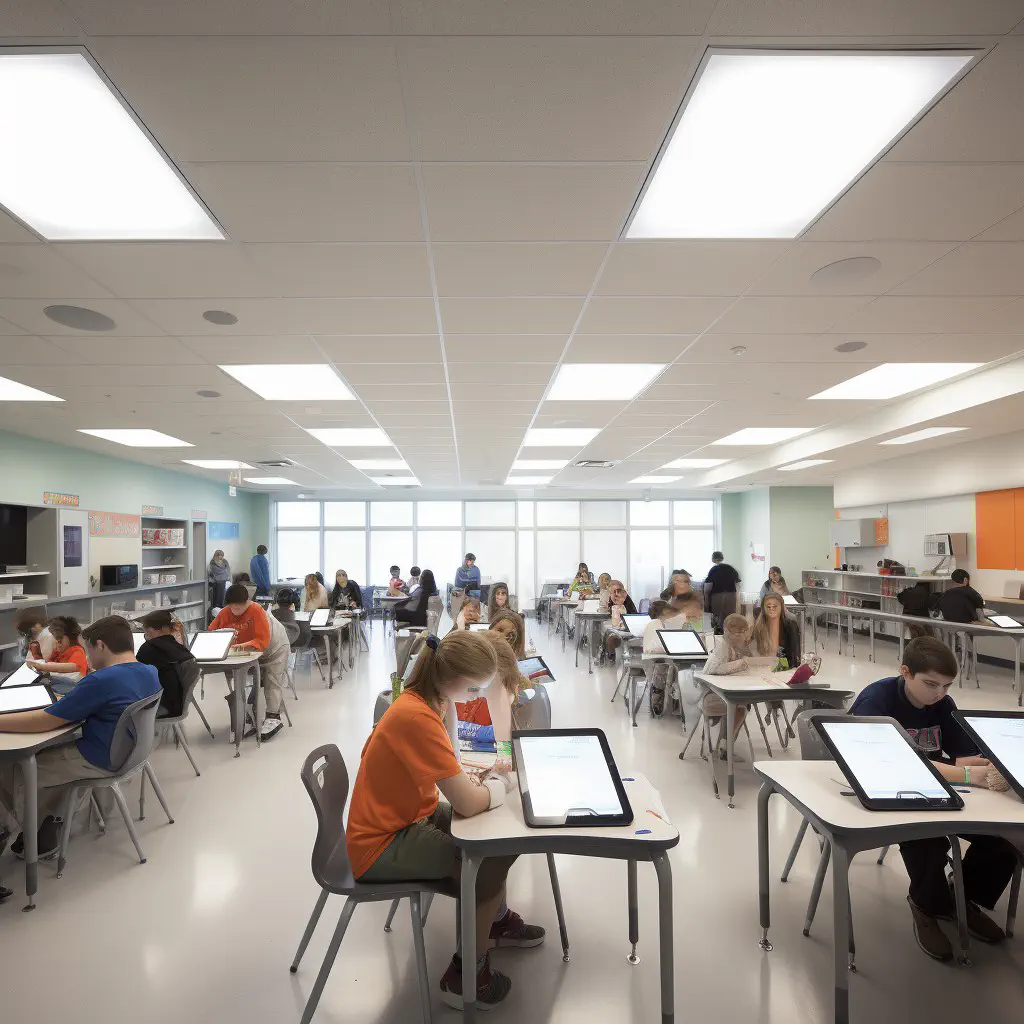
Introduction
Adaptive learning is a educational technology that has been transforming the way students learn in the classroom. It is an innovative approach that tailors instruction to meet the unique needs of each student. By providing customized learning paths, adaptive learning can help educators create a personalized and engaging educational experience for their students.
Adaptive learning offers several benefits that make it a valuable tool for any classroom. It can improve academic performance, increase student engagement, and save teachers time by automating some aspects of instruction. Moreover, students are able to work at their own pace, which helps them gain a deeper understanding of the material.
In this guide, we will explore the different aspects of adaptive learning and its importance in the classroom. We will cover everything from defining adaptive learning to creating adaptive learning modules. Additionally, we will provide tips and strategies that educators can use to implement adaptive learning successfully.
Understanding Adaptive Learning
Adaptive learning is a teaching method that utilizes computer algorithms to provide personalized learning experiences to individual students. Rather than a one-size-fits-all approach, the adaptive learning system adjusts the curriculum and assessment to the student’s pace, learning style, and abilities.
Definition of Adaptive Learning
Adaptive learning is a technique that leverages technology to optimize learning experiences based on individual student needs. It utilizes advanced analytics to assess the student’s abilities and progress, and then customizes the learning process to enhance academic performance.
How it Works
Adaptive learning systems collect data on student progress through continuous assessments, monitoring of their learning style, and user feedback. This data is analyzed to understand the strengths, weaknesses, and learning preferences of individual students. The adaptive learning system then uses these insights to create customized learning experiences, adjusting the content, difficulty level, and pace to meet each student’s needs.
Types of Adaptive Learning
Adaptive learning can take many forms, including different types of software and platforms such as online learning tools, intelligent tutoring systems, and gamified learning. Each type has unique capabilities and features, but all share the goal of personalizing the learning experience for each student.
Benefits of Adaptive Learning in the Classroom
Adaptive learning is a powerful tool for both educators and students. It provides a personalized learning experience that caters to each individual’s unique learning needs. Here are some benefits of using adaptive learning in the classroom:
Personalized learning experience
One of the most significant benefits of adaptive learning is that it provides a personalized learning experience for students. With adaptive learning, the curriculum is tailored to each student’s learning level and style, allowing them to learn at their own pace.
Increased student engagement
Adaptive learning engages students by making the learning process challenging and rewarding. The software adapts to the student’s performance, generating immediate feedback that helps to ensure a sense of accomplishment and greater motivation to continue learning.
Significant improvement in academic performance
Students who use adaptive learning software have shown significant improvement in academic performance, compared to students using traditional methods. Adaptive learning software allows students to learn effectively and efficiently, ensuring that they master the concepts they need to succeed.
Time-saving for teachers
Adaptive learning software can save teachers an enormous amount of time. It can automate routine tasks such as grading, generating lesson plans, and tracking student progress. This frees up time that teachers can use to focus on other aspects of their jobs, such as planning engaging lessons and giving feedback to students.
Adaptive learning has tremendous potential to improve the quality of education and make it more accessible to learners of all ages and backgrounds. With its personalized, engaging, and effective approach to learning, it is clear that adaptive learning is the way of the future.
Getting Started with Adaptive Learning
To get started with Adaptive Learning, there are a few steps that must be taken for effective implementation. We will discuss each of these steps below:
Conducting a Needs Assessment
Before implementing an adaptive learning program, it is crucial to conduct a needs assessment to understand what the students need to learn and how they learn best. Assessing the learning needs will ensure that the adaptive learning approach is tailored to the needs of the students. To conduct an effective needs assessment, teachers can:
- Gather data on student learning patterns: This can be achieved by collecting data on student performance, learning styles, and student feedback.
- Analyze data: Analyzing student data will help teachers identify gaps in student knowledge and determine the best way to deliver content.
- Choose the right assessment tool: Teachers can choose from the available assessment tools to gather the right data to understand student’s educational needs.
Choosing the Right Adaptive Learning Software
Choosing an adaptive learning software that is right for the student population, course level, and subject matter is crucial for effective implementation. Teachers can do the following when selecting adaptive learning software:
- Research adaptive learning software: Teachers should research adaptive learning software options before making a decision. Many vendors offer free demos and trials that can provide a good idea of what the software is like.
- Evaluate software based on the specific needs: Teachers must evaluate the software based on how well it aligns with the needs of their learners. A good adaptive learning program should be able to address any student gaps in knowledge while also adapting to each learner’s pace.
- Consider the cost: Adaptive learning systems can be expensive. Teachers need to consider the cost of adopting the software and if it fits within the budget.
Training and Support for Teachers
Teachers need to be equipped with the skills and knowledge to use adaptive learning software effectively. Understanding the software’s features and how to integrate them into instructional settings is crucial. Teachers can be trained by:
- Participating in workshops or online courses: There are workshops or online courses teachers can take to learn about adaptive learning software.
- Consulting with the vendor: Vendors offer training to educate teachers on the software’s features and how to make the most of them.
- Utilizing online resources: Adaptive learning software vendors provide online resources like user manuals and video tutorials to help teachers use the software effectively.
Creating Adaptive Learning Modules
Creating adaptive learning modules involves selecting content that is aligned with the course’s objectives, ensuring that the content is relevant, engaging, and interactive. Teachers can create adaptive learning modules by:
- Diving into digital content: Teachers can choose from a vast pool of digital content available. Content should be selected based on its relevance to the specific needs of the student and course objectives.
- Integrating multimedia: Multimedia content can hold student attention and provide a more engaging learning experience.
- Tracking progress: Teachers should track student progress to identify areas that need improvement and adjust adaptive modules as needed.
By following these steps, teachers can effectively implement adaptive learning in the classroom.
“Adaptive learning is not a one-size-fits-all solution; it is systematic, dynamic, and always evolving.”
Implementing Adaptive Learning
Implementing adaptive learning in the classroom can be a daunting task, especially for teachers who are new to using this innovative technology. It is important to approach the implementation process in a well-planned and structured manner to ensure that the technology is used effectively, and learning outcomes are achieved. Here are some tips to help you effectively implement adaptive learning in your classroom:
How to Integrate Adaptive Learning into a Lesson Plan
Adaptive learning is not intended to replace traditional teaching but rather to be integrated into lesson plans to enhance the teaching process. Teachers can start by identifying subject areas or topics where adaptive learning can best be applied. This can involve working with education technology specialists or providing students with access to a variety of online learning platforms.
Tips for Effective Implementation
Making adaptive learning effective requires incorporating it into the learning objectives. Teachers should therefore set objectives that align with the learning requirements of students. Specific goals should be set and supported by personalized learning materials that help to meet each student’s learning needs. Teachers should also monitor student progress closely and make necessary updates to the learning materials.
Measuring Success with Adaptive Learning
Using relevant metrics can help teachers measure the effectiveness of adaptive learning. Usage data such as the number of completed tasks, student engagement with the learning material, and the amount of time spent on various tasks by different learners can be used to track progress and identify areas that require improvement.
Conclusion
As adaptive learning is still relatively new technology, you may face challenges or problems when integrating it into your teaching program. However, it is crucial to remember the benefits that adaptive learning provides, such as personalized learning, increased student engagement, and significant improvement in academic performance. By following these tips, you can effectively integrate adaptive learning into your lesson plans and ensure that your classroom provides the best possible learning outcomes for your students.
Challenges and Solutions
Adaptive learning is an innovative approach that seeks to customize the learning experience for each student. As with any new technology, adaptive learning presents some challenges that teachers must overcome to ensure the optimal benefit for their students. Some of these challenges include:
Challenges
-
Resistance to Change: Some teachers may be resistant to change, especially if they have been teaching in the same way for years. Convincing them to switch to a new learning model may be difficult.
-
Lack of Training: Teachers may lack the technical skills required to use adaptive learning software effectively. This can be particularly challenging for older teachers who may not be comfortable using new technology.
-
High Cost: Adaptive learning software can be expensive, especially for schools that may not have the resources to purchase it.
-
Data Privacy Concerns: One of the key benefits of adaptive learning is its ability to collect data on students to personalize their learning. However, this raises concerns about data privacy and whether the data collected is being used ethically.
Solutions
-
Professional Development: Teachers need to be trained on how to effectively use adaptive learning software. Providing regular professional development sessions can help teachers learn how to use the new technology, which can lead to greater adoption and more significant impact.
-
Cost-Effective Alternatives: Schools can explore other cost-effective ways to introduce adaptive learning into their curriculum, such as open-source learning software or partnering with neighboring schools.
-
Addressing Data Privacy Concerns: To mitigate concerns about data privacy, schools can work with their vendors to ensure they comply with applicable privacy laws. Additionally, schools can set up their own data warehouses or servers to store and manage student data.
-
Flexibility: Providing teachers with flexibility and choice in how they implement adaptive learning can help overcome resistance to change. Teachers who are given the autonomy to experiment and integrate adaptive learning into their teaching can help increase adoption across the school and help realize the benefits of adaptive learning.
Conclusion
While there are some challenges associated with adaptive learning, these can be mitigated with the right strategies and planning. As technology continues to advance and student needs evolve, it’s crucial for schools to explore new models of learning to meet these changing demands. Adaptive learning offers a promising solution that can help students reach their full potential. By addressing key challenges, teachers can start to implement this innovative approach and benefit from the personalized learning experience it brings.
Conclusion
In conclusion, adaptive learning is a powerful tool that can revolutionize the way students learn in the classroom. By providing personalized learning experiences, engaging students in new and exciting ways, and improving academic performance across the board, adaptive learning has quickly become one of the most popular educational technologies available today.
As we’ve explored throughout this article, there are many benefits to using adaptive learning in the classroom. These benefits range from increased student engagement to time-saving for teachers – and everything in between.
If you’re considering implementing adaptive learning in your own classroom, it’s important to start by conducting a needs assessment and choosing the right software that meets your specific needs. From there, you’ll need to provide training and support to teachers, create adaptive learning modules, and integrate them into your existing lesson plans.
It’s also important to remember that there may be challenges that arise when implementing adaptive learning, but there are also many solutions readily available. By taking the time to understand these challenges and prepare for them, you can help ensure a successful implementation of adaptive learning technology in your classroom.
Ultimately, the future of adaptive learning is bright, and with the right tools and strategies in place, it has the potential to change the face of education as we know it. So don’t hesitate – start exploring the possibilities of adaptive learning in your classroom today!

